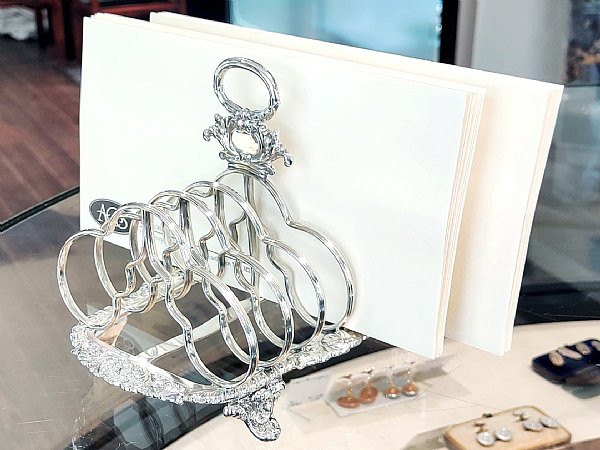Search Results for: '{{searchText}}'
Sorry...
We don't seem to have what you're looking for.
However we do have thousands of magnificent pieces of silver and jewellery available for you to view online. Browse our store using one of these categories.
Please wait for loading data... 
AC Silver is proud to present a fine selection of antique & vintage toast racks for sale.
Antique silver toast racks and toast holders have long been cherished for their ornate beauty and functional design. In addition to holding your toast on the dining table, these silver holders can also be utilised as letter holders for the office.
Andrew Campbell hand selects only the finest silver toast racks to add to the AC Silver inventory.
All of the antique and vintage toast racks at AC Silver come with free and insured worldwide shipping and a 14 day return policy.

A toast rack is a serving piece that is used primarily at the start of the day- for breakfast. It has vertical partitions that are connected to a base, the amount of vertical partitions usually ranging from five to eight. The gap between these partitions are used to contain toast. At the top of the toast rack there is sometimes a ring, this allows the toast rack to be easily passed around the table.
Some toast racks have trays underneath to collect the crumbs in; allowing for easy crumb disposal.
Due to the gaps between the partitions the toast refrains from becoming soggy, as it does when it is simply placed on a plate. The toast rack allows the vapour to escape from the toast, hence why it was a quintessential object to have in the home.
There are even designs of toast racks that include egg cups, and pots for butter and other breakfast condiments, as well as folding toast racks which are ideal for compact storage (patented by Roberts Cadman & Co in 1807) and novelty toast racks which were popular in the late 19th and early 20th century featuring shapes such as wishbones, hearts and crossed riding whips. One of the most iconic designs is the Campden toast rack, a simple, stainless steel item first produced in 1956, made in four or six slice options.
Despite the fact that the consumption of toast dates back to the Roman era ("Tostum” being Latin for "scorched”), the development of the toast rack did not happen until the 18th Century. Up until this point any innovation revolved around the making of the toast rather than the presentation; this development took us from the humble hot stone, on to the wire frame used to toast bread above fire, then to the toasting fork (which was greatly popular during the Victorian era) and finally to the toaster, introduced in 1893 by the British Crompton company.
It is claimed that the first toast holder was crafted in the 1770’s with them first appearing on the breakfast table around the 1780’s as part of the general refinement of dining customs amongst the middle classes. The first reference in print to the toast rack was in a report of a burglary in 1779 - A antique silver toast rack worth two pound (which would have been a relatively large amount at the time) was amongst a number of domestic silver items which were reported to have been stolen from the home of John William Anderson by two Burglars who were later tried at the Old Bailey.
It is thought that the first toast racks started emerging because of the relatively new technique of fusing metal plate wires in the rolling mills in the 1760’s. This involved a thin strip of sterling silver being bent around a circular piece of copper, about five centimetres in diameter. After the wires were fused the bar was then drawn through a series of wholes, which decreased the bar in size until wire of the specified diameter was reached. This new manufacturing technique heavily influenced designs at the time, as it meant that thin metal could be mass manufactured in order to create quite delicate pieces, often pieces that were quite metal-light. The toast rack is such a piece of course, as it relies on large gaps to achieve the soggy-free ideal toast.
This concept of the perfect dry toast was echoed a lot in 18th and 19th century cook books such as Mrs Beeton’s Dictionary of Every-Day Cookery (1865) in which she writes "to make dry toast properly, a great deal of attention is required; much more, indeed, than people generally suppose.” and then goes on to assert that the answer, of course, is the implementation of the toast rack.
Since that time the toast holder has never really been out of fashion, with new cheaper materials giving not just those belonging to the upper and middle classes the ability to purchase an item to enhance the breakfast experience. Some have found other purposes for the toast rack, for example: a letter holder, a place to keep electronic gadgets, plate holders, etc.




